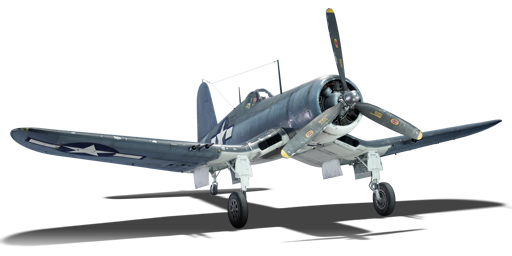



The F4U-1C was among one of the rarest variants of the F4U Corsair, with only ~200 made, and was the first Corsair to be armed with cannons. The 1C was essentially an F4U-1D with 4 x 20 mm Hispano guns and gave the aircraft a more potent armament against ground targets and aircraft. As good as the guns seemed on paper, in practice it was very different. American pilots found the guns unreliable and excessive against the lightly armoured Japanese aircraft. Many pilots preferred the M2 Browning machine guns due to their large ammo pool and reliability. Although the new guns made the F4U-1C more deadly, they came at the price of hampering performance with added weight.
The F4U-1C, which has been in War Thunder since the start of the Open Beta Test, is like many of the other Corsairs in-game when it comes to performance. It's incredibly fast and allows the Corsair to excel at Boom and Zoom tactics. With the addition of Hispano cannons, the F4U-1C will easily destroy enemy aircraft with a slight burst and is incredibly effective against ground targets. However, much like in real life, the Hispanos are prone to jamming when stock. Nonetheless, it is the lowest battle rating Corsair with cannons and sets it apart from every Corsair near its battle rating.
flaps
flaps
flaps
brake
| Belt | Belt filling | Armor penetration (mm) at a distance: | |||||
|---|---|---|---|---|---|---|---|
| 10 m | 100 m | 500 m | 1000 m | 1500 m | 2000 m | ||
| HEF-I/AP-T | 39 | 36 | 25 | 16 | 10 | 6 | |
| AP-T/AP-T/HEF-I/HEF-I | 39 | 36 | 25 | 16 | 10 | 6 | |
| HEF-I/HEF-I/HEF-I/AP-T | 39 | 36 | 25 | 16 | 10 | 6 | |
| AP-T/AP-T/AP-T/HEF-I | 39 | 36 | 25 | 16 | 10 | 6 | |
| HEF-I | 5 | 4 | 3 | 2 | 2 | 2 | |
| Belt | Belt filling | Armor penetration (mm) at a distance: | |||||
|---|---|---|---|---|---|---|---|
| 10 m | 100 m | 500 m | 1000 m | 1500 m | 2000 m | ||
| HEF-I/AP-T | 39 | 36 | 25 | 16 | 10 | 6 | |
| AP-T/AP-T/HEF-I/HEF-I | 39 | 36 | 25 | 16 | 10 | 6 | |
| HEF-I/HEF-I/HEF-I/AP-T | 39 | 36 | 25 | 16 | 10 | 6 | |
| AP-T/AP-T/AP-T/HEF-I | 39 | 36 | 25 | 16 | 10 | 6 | |
| HEF-I | 5 | 4 | 3 | 2 | 2 | 2 | |












Flight performance | |
|---|---|
Survivability |
|---|
Weaponry | |
|---|---|